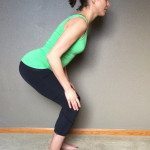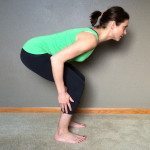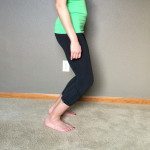The squat is a functional movement essential to transfer our body weight down and back up through space. It allows us to hover near the ground for work in the garden, to sit down into a chair and to get us low enough to grab a pan in a bottom cabinet. It’s a great movement (and exercise) that develops hip, knee, ankle, back and trunk musculature. But, there’s controversy out there. How low does a squat need go in order to be considered a squat?
The Deep Squat
I [1]t’s deep. Most of us don’t squat this low. It’s how toddlers squat. My 2-year old does this often to play with his blocks. It works for him…because he is 2 years old. He’s not concerned with shear or compressive forces on his knee. He doesn’t really care if his gluteus maximus (GMax) is working or not. He does it because it feels natural, functional and doesn’t hurt. Theoretically, should we be able to do a deep squat? Maybe. But, all of us age differently and that should be taken into account.
[1]t’s deep. Most of us don’t squat this low. It’s how toddlers squat. My 2-year old does this often to play with his blocks. It works for him…because he is 2 years old. He’s not concerned with shear or compressive forces on his knee. He doesn’t really care if his gluteus maximus (GMax) is working or not. He does it because it feels natural, functional and doesn’t hurt. Theoretically, should we be able to do a deep squat? Maybe. But, all of us age differently and that should be taken into account.
Requirements to perform a deep squat
- Significant ankle, knee and hip joint range of motion
- Excellent muscle activation of the GMax, quadriceps, hamstring and gastrocnemius
- A stellar core
- A long, stable spine
Blog Activity: Perform a Deep Squat
Place your feet under your hips. Keeping your spine erect, squat down until your thighs come in contact with your lower leg (tibia). Your knees should be over your feet and your heels should stay in contact with the floor. Whew! (Did you fall down trying to do this?!)
Can most of us perform a deep squat? Nope!
Is a squat still a squat if I can’t go that low? Yep!
As we age, not all of us are meant to touch the back of our thigh to our leg. Some of us have better joint genetics. Some of us have different bony anatomy. Some of us are more active in our younger years and that leads to easier movement as we age. But, I hear from patients often: “My fitness instructor or personal trainer doesn’t think I’m doing a real squat”. I beg to differ.
The Functional Movement Screen (FMS) and other forms of exercise (i.e. CrossFit) have popularized the deep squat. Performed the FMS way, the deep squat gives information about ankle, hip and knee range of motion, thoracic spine extension, core stability and shoulder overhead motion (they require holding a dowel overhead). Is it a good test? Sure. Does it apply to every population? Absolutely not. But, unfortunately, this screen has made people feel that the only way to “truly squat” is to go deep…pain or no pain. Remember, normal movement (your normal movement) should not be painful.
The justification of the FMS is that we should be able to squat like a baby. If you have healthy joints, amazing GMax strength and it feels comfortable, great! Deep squat away! But, for most of us, this is not the case. I do not teach my patients to squat like a baby. But, I also don’t teach them to go down the stairs on their stomach, roll around on the floor or suck their thumb. I think you get my point. I mention this paragraph because this is the big piece of controversy: That a squat is only a deep squat. And, if our butt is not close to the ground, we are failing at the movement or exercise.
What is the danger of deep squat?
The knee menisci, cruciate ligaments and collateral ligaments of the knee are more susceptible to injury. And, if you have any degenerative changes occurring in your hip or knee (i.e. osteoathritis), a deep squat will likely be painful. If I have a patient with a total hip or knee replacement, a deep squat is not even an option. How unfortunate would it be if I said: “Well, sorry, you’re never going to be able to squat again because you can’t get low enough.” A squat is still a squat, regardless of depth.
The Functional Squat (what I teach in the clinic)
This is a body weight squat that will ultimately bring the thighs parallel to the ground. I use the cue: “Squat like you’re sitting into a chair”. It’s a squat to teach patients and athletes how to engage their GMax and core, while maintaining a long spine. It takes the compressive forces off the knee and teaches the hip musculature to do a little bit more work. It’s safe and works well for function and sport.
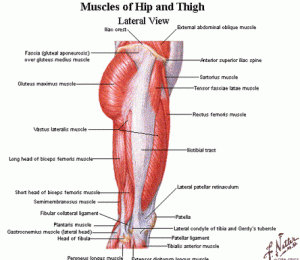 [2]The squat is controlled by muscular contraction. The depth is limited by the strength and proprioception (body sense) of the GMax. The quad, hamstrings and calf muscles are working too, but this squat puts the GMax into the driver’s seat. Clinically, I am not concerned with depth at first; that will come in time. I am interested if the patient is using their GMax. Can they feel it? I am interested in their core. Is it engaged? And, I am super interested if it’s pain-free. Mastering the functional squat takes time, good lower extremity muscles and a strong spine/core. And, it sets the patient up for the ultimate sports progression: the single leg squat. (Stay tuned for next weeks post: Pilates for Triathletes Run Part I: Mastering the Single Leg Squat).
[2]The squat is controlled by muscular contraction. The depth is limited by the strength and proprioception (body sense) of the GMax. The quad, hamstrings and calf muscles are working too, but this squat puts the GMax into the driver’s seat. Clinically, I am not concerned with depth at first; that will come in time. I am interested if the patient is using their GMax. Can they feel it? I am interested in their core. Is it engaged? And, I am super interested if it’s pain-free. Mastering the functional squat takes time, good lower extremity muscles and a strong spine/core. And, it sets the patient up for the ultimate sports progression: the single leg squat. (Stay tuned for next weeks post: Pilates for Triathletes Run Part I: Mastering the Single Leg Squat).
Blog Activity: Perform a Functional Squat
- Find a chair to practice with
- Stand in front of the chair with your feet hip distance apart
- Initiate the squat by bending at the hips (stick your butt out) and let the knees bend
- Keep the spine long, core engaged and chest lifted
- Keep the knees tracking over the 2nd toes
- Pretend you are going to “kiss your bum” to the chair
- Return to standing
If you can easily “kiss your bum” to the chair, try a lower surface. I instruct my patients to use the 2nd step from the bottom as the optimal depth to master a functional squat.
To answer the question: How Low Should You Go? Go as low as you can feel the movement controlled by muscular work and as low as it does not hurt!
Common Compensations of The Squat
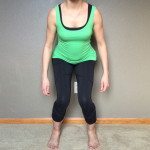 [3]An ACL injury waiting to happen– the squat is dominant in adduction (legs fall toward midline) and internal rotation (femurs role in). Women tend to do this more than men, especially teenage athletes.
[3]An ACL injury waiting to happen– the squat is dominant in adduction (legs fall toward midline) and internal rotation (femurs role in). Women tend to do this more than men, especially teenage athletes.
[su_spacer size=”50″]
Lumbar extension occurs at end-range- the squat is initiated at the hips, but as the squat goes lower the lumbar spine extends because of poor core control and spinal strength. When loaded with weight, this compensation can be very dangerous to the lumbar discs.
[su_spacer size=”50″]
The bird peck– the squat is initiated by a forward trunk lean, with minimal movement at the knees and hips. This will not develop the leg muscles.
[su_spacer size=”50″]
The knees push past the toes– the squat is initiated by the knees bending and being pushed over the toes. Minimal hip movement is occurring, so you know GMax is asleep. This is what I say to my patients: “You’re basically jamming your femur into your patella. Ouch.”
[su_spacer size=”50″]
© 2014 and Beyond. ALL BLOG CONTENT at duncansportspt.com by Lori Duncan PT
 ABOUT THE AUTHOR
ABOUT THE AUTHOR
Lori Duncan, DPT, MTC, CPT is a respected Physical Therapist, Manual Therapist and Pilates instructor in Lafayette, CO. Lori is passionate about preventive physical therapy and education and is a nationally recognized presenter. She can be reached at [email protected]. You can also follow Duncan Sports Therapy + Wellness on Facebook [7] & Instagram [8] for more free tips and information.
References
Cook G, Burton L, Hoogenboom B, Voight M. Functional movement screening: the use of fundamental movements as an assessment of function- part I. Int J Sports Phys Ther. 2014;9(3):396-409.
Escamilla R. Knee biomechanics of the dynamic squat. Med Sci Sports Exerc. 2001;33(1):124-141.
Powers, C.The influence of abnormal hip mechanics on knee injury: a biomechanical perspective. J Orthop Sports Phys Ther. 2010;40(2):42-51.
